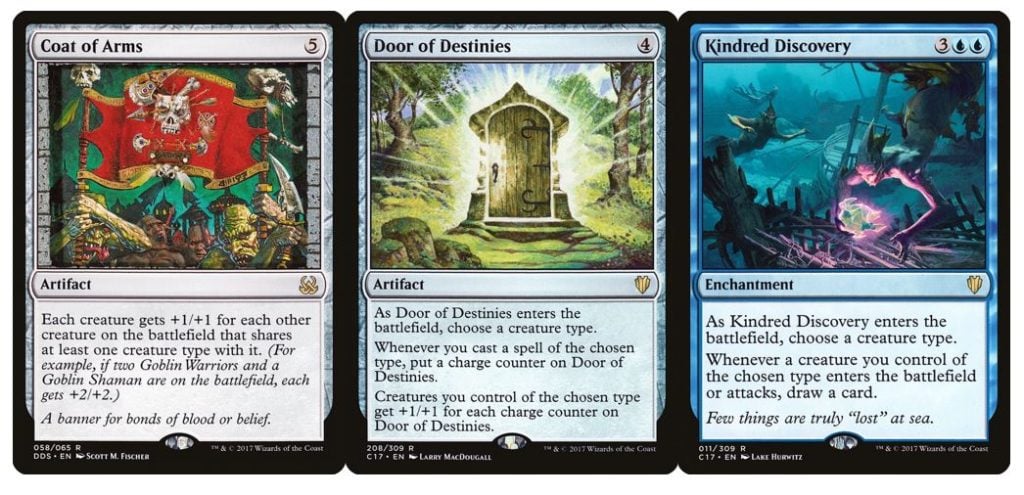Innistrad isn’t just the horror plane of the Multiverse — it’s also home to many of the most iconic creature types in Magic. With Midnight Hunt in full swing and Crimson Vow on the horizon, players are busy updating their Werewolf, Vampire, and Zombie decks. Now is the perfect time for it, which is why I’m taking a closer look at tribal decks this week.
Every Commander player has a soft spot for a particular creature type. Whether it’s Goblins, Elves, Vampires, Dragons, or even Merfolk, tribal decks have always been some of the most popular archetypes. They have a strong sense of deck identity; all the pieces work in concert, and even the more casual list can feel like a well-oiled machine.
Many tribal decks tend to run a number of generically powerful staples. These cards reward you for playing more of the same creature type, but can also apply to any creature type.

But some of these staples can be prohibitively expensive, and they can even make for a suboptimal gameplay experience (if you’ve ever tried to work out combat math while Coat of Arms was on board, you’ll know exactly what I mean). As soon as players see a Door of Destinies or Kindred Discovery, they tend to set their sights on destroying them. These cards provide too great an advantage to go unnoticed; they could make you the archenemy at the table, even if you don’t gain any value from them!
As most themed decks are filled with the same supports and buffs for creatures, they run the risk of becoming formulaic; “auto-includes” like these are so popular that most players know exactly what’s coming. Thankfully, there are plenty of replacements for your Door of Destinies or Herald’s Horn that won’t provoke your opponents.
I’ve listed some of my favorite tribal support cards to help you find the right pieces for your deck. To ensure this list is as accommodating and inclusive as possible, all of these cards are around $5 or less. Whether you’re looking for budget substitutes or just something different to set your deck apart, I’ve got you covered.
Ramp & Cost Reduction
What’s better than an Arcane Signet? A second one! Pillar of Origins is one of the best ramp options for creature-heavy decks, and it gets better the more colors you play. Dragons, Slivers, or Allies will make the best use of this, but Vampires and Dinosaurs will still be happy to run a Pillar in the 99.
If you’re after a more hipster option, Mistform Warchief is the oat milk flat white for you. It can change its creature type every turn, which is great if your deck cares about more than one type of creature. It’s particularly good for nonspecific tribal decks that have multiple creature types, like “Sea Creatures” (Leviathan, Octopus, Serpent, etc).
Belbe’s Portal is a fantastic cost reducer, effectively letting you cheat a creature into play every turn for three mana. It has a reasonable initial investment at five mana, but you can reap the rewards after just a couple activations. It’s not ideal in decks with smaller creatures, like Elves of Goblins, but more expensive creatures like Krakens, Leviathans, or Eldrazi will make exceptional use of this artifact.
Value
Even if you’re not playing with Elves or Clerics, Skemfar Shadowsage might be a good fit for your deck. In the right deck it’s a more impactful Gray Merchant of Asphodel, giving you some reach and helping you close the game through board stalls. You may not always get to gain life, but the option to keep afloat is still there. Elves and Clerics will get the most out of this card, but any go-wide deck can reap the benefits.
If you’re looking to double up on value, Molten Echoes has you covered. Nearly every tribal deck has some number of creatures that provide value when they enter the battlefield; this enchantment lets you take advantage of them even more than before. Not only does it give you additional copies of your creatures, but they gain haste for some extra aggression! The tradeoff is that the copies disappear at end of turn, so be sure to make their brief presence felt. Goblins are particularly good at benefitting from this, as most of the Goblin decks have some sort of sacrifice subtheme.
Reflections of Littjara is ideal for any deck that runs blue, giving you extra value from every creature you cast. As with Molten Echoes, almost every tribal deck has creatures with enter the battlefield abilities, so doubling them would be akin to a Panharmonicon that gives you extra bodies. Rogues and Pirates can make great use of this enchantment (they can go wide with small creatures), but Merfolk is probably the best fit. Merfolk has a critical mass of lord effects, and copying them can lead to a terrifying snowball effect!
Speaking of which…
Lord Effects
“Lord” effects are usually permanents that increase the stats of creatures with a quality in common, often a creature type. These are often the biggest draw to specific creature types.
Obelisk of Urd can supercharge a board of tiny creatures in a way that most cards cannot. The +2/+2 bonus is a large buff, and the Obelisk will often cost nothing, thanks to convoke. You can spend most of your mana deploying a board, then use those creatures to pay for Obelisk; convoke doesn’t care whether the creatures are summoning sick, so correct sequencing can give you a huge boost of power.
Some creature types, like Bears or Spiders, lack the kind of synergistic support you’ll find in other tribal decks. Adaptive Automaton is a huge boon for these decks, giving their creatures a way to reliably grow in size. Automaton can also benefit decks that aren’t tribal themed, like strengthening Talrand, Sky Summoner’s Drake tokens.
Many creature types, like Merfolk and Elves, have access to specific creatures that serve as lords. This is fine, but it does make these decks more susceptible to board wipes and removal. Icon of Ancestry isn’t just harder to remove — it lets you convert excess mana into more gas. Just like with Adaptive Automaton, it’s also a nice addition to the likes of Ayula, Queen Among Bears or Magda, Brazen Outlaw, where creature buffs are few and far between.
Sacrifice Value
Some tribal decks may be less combat-focused, so they can have a few spare creatures on the battlefield. There are plenty of ways to turn those creatures into more value, and some can even synergize with the deck’s core theme.
Pyre of Heroes is a sort of “fixed” Birthing Pod, but it’s still a powerful tool in the right decks. It’s useful as a repeatable creature tutor, turning your deck into a toolbox to tackle any situation. Sacrificing a creature can often come with upside, too: I had an Orah, Skyclave Hierophant deck that made incredible use of this. His ability would give me back a creature from the graveyard whenever Pyre was activated! Wort, Boggart Auntie can make great use of this, too, thanks to both her ability and the sacrifice subtheme associated with Goblins.
If you’re less interested in tutoring for specific creatures, Heirloom Blade is the perfect tool for incidental value. It’s always guaranteed to hit a relevant creature in your deck, effectively replacing the equipped creature every time they die. It can act as a mild deterrent for removal, especially with such a low re-equip cost; it can sometimes give you more time with the equipped creature than your opponents may like.
Species Specialist is not only great in decks with sacrifice fodder — it’s also incredible insurance against a board wipe. If your Elves deck gets hit with a sweeper, you could draw half the remaining cards in your deck! Any deck that wants to commit heavily to the board and/or sacrifice creatures will love this powerful Warrior.
Honorary Creatures
Most of the cards we’ve talked about are either enablers or rewards for playing creatures with the same type. There’s one other category of cards that I think is worth covering: Shapeshifters! These creatures have every creature type, so they won’t dilute the number of relevant creatures in your deck.
If you have a deck with a large number of cheap creatures, Realmwalker is the Shapeshifter for you. Their Future Sight-like ability can spew a stream of cheap threats from the top of your library with ease, effectively drawing you several cards per turn. While Elves and Merfolk can make the most of Realmwalker’s power, any deck full of creatures will benefit from this fantastic piece of card advantage.
In my opinion, any deck that can accommodate a Clone effect should consider doing so. Littjara Mirrorlake lets you fit one into your mana base at very little cost. You can copy a Species Specialist for double the card draw, or get a second Adaptive Automaton to stack your team’s buffs. It won’t fit in every deck due to its color restrictions, but it’s incredible when you can include it.
Finally, one of the most famous Shapeshifters is Mirror Entity, which can threaten a lot of damage. The smaller your creatures and the wider your board, the more of an impact Mirror Entity will have. You can activate it at instant speed, and the mere threat of activation can be problematic for opponents. Rin and Seri, Inseparable can make especially good use of this effect, given that Mirror Entity counts as both a Dog and a Cat.
Not all decks need to run the same few staples to be able to keep up with the table. More often than not, they can restrict your deck building choices and homogenize your gameplay experiences. Whether you’re brewing a tribal deck for the first time or updating a longtime favorite, I hope you’ve found something useful here.
Do you have any special tech that you think more players should know about? I’d love to hear your thoughts over on Twitter!

Scott is an Irish content creator and the Head of Budget Magic for the Izzet League. He focuses on affordable decks in Pioneer, Modern, and Pauper, particularly ones that stray from the mainstream. When he’s not writing about his favorite decks, he can be found talking incessantly about them on Twitter and on The Budget Magic Cast.

